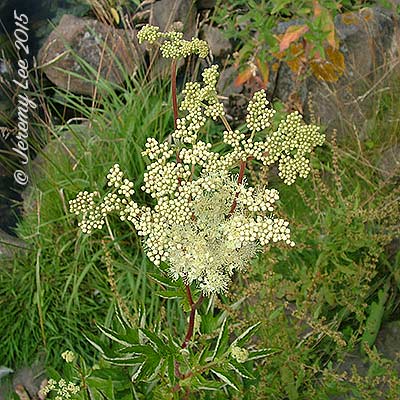
 |
|
Scientific Classifications explained » Amphibians » Ants » Aphids » Bees » Beetles » Birds » Bugs » Butterflies » Caterpillars » Damselflies » Dragonflies » Earwigs » Flies » Frog/Leafhoppers » Fungi » Galls » Grasshoppers » Harvestmen » Hoverflies » Lacewings » Ladybirds » Leaf Mines » Lichens » Mammals » Millipedes » Mosses » Moths » Sawflies » Slugs » Snails » Spiders » Trees » Wasps » Wild Flowers » Woodlice |
UK Nature > Wild Flowers > White Wild Flowers > Filipendula ulmaria

Scientific Name: Filipendula ulmaria Common Name: Meadowsweet Filipendula ulmaria, commonly known as Meadowsweet, is a perennial herb in the family Rosaceae that grows in damp meadows. It is native throughout most of Europe and Western Asia (Near East and Middle East). It has been introduced and naturalised in North America. The stems are 1–2 m (3.3–6.6 ft) tall, erect and furrowed, reddish to sometimes purple. The leaves are dark-green on the upper side and whitish and downy underneath, much divided, interruptedly pinnate, having a few large serrate leaflets and small intermediate ones. Terminal leaflets are large, 4–8 cm long, and three- to five-lobed. Meadowsweet has delicate, graceful, creamy-white flowers clustered close together in irregularly-branched cymes, having a very strong, sweet smell. They flower from early summer to early autumn and are visited by various types of insects, in particular flies of the Musca genus. Meadowsweet leaves are commonly galled by the bright orange-rust fungus Triphragmium ulmariae, which creates swellings and distortions on the stalk and/or midrib. |
|

https://www.uknature.co.uk is a website dedicated to showing the immense diversity of UK nature and wildlife. Our vast range of habitats, from lowland arable to snow covered mountains, from storm-ravaged coastlines to peaceful inland freshwater lakes and rivers, from dry, sandy heaths to deciduous and coniferous forests, all these habitats contribute to the abundance of UK nature. We have wild birds in huge numbers either residing or visiting our shores (597 recorded species as at July 2013) and we must also not forget the humble back garden with its grass lawns, flower beds filled with nectar rich flowers, shrubs and trees, all designed to attract huge numbers of insects such as bees, moths, butterflies and hoverflies; and finally the small ponds which provide safe havens for frogs, toads, newts and even slow worms and grass snakes. www.uknature.co.uk is the showcase for my personal passion, photographing uknature in all its glory. I sincerely hope you all enjoy the fruits of my labours. This site and all images contained therein is © Jeremy Lee 2004 - 2021. All Rights Reserved. Site design by Jeremy Lee. Site development & IT Support by Stuart Lee. |